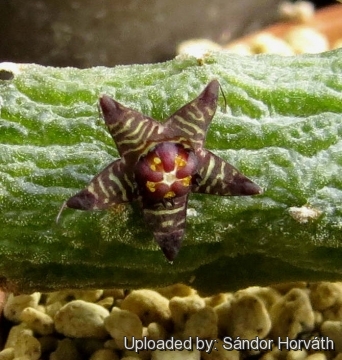
Rhytidocaulon macrolobum var. minima Photo by: Sándor Horváth
Origin and Habitat: Yemen?
Synonyms:
See all synonyms of Rhytidocaulon macrolobum
Description: Rhytidocaulon macrolobumSN|527]]SN|527]] var. minima is a poorly known dwarf, compact growing form with small flowers from Yemen.
Rhytidocaulon macrolobumSN|527]]SN|527]] var. minima is NOT the same as Rhytidocaulon macrolobumSN|527]]SN|527]] subs. minimum Meve & Collen which is a distinct plant from Saudi Arabia with a very different flower's structure.
 Rhytidocaulon macrolobum var. minima Photo by: Sándor Horváth
Rhytidocaulon macrolobum var. minima Photo by: Sándor HorváthSend a photo of this plant.The gallery now contains thousands of pictures, however it is possible to do even more. We are, of course, seeking photos of species not yet shown in the gallery but not only that, we are also looking for better pictures than those already present.
Read More... Cultivation and Propagation: This is a summer-growing species that like many of the plants of this family which comes from Arabia and Yemen is not easy to cultivate. This plant is extremely xerophytic, adapted to very dry soils and is quite susceptible to over-watering if kept in a non ventilated place.
Growth rate: Relatively fast-growing that offsets freely to form small clusters quickly.
Soil: Grow it in an open mineral, sandy-gritty cactus compost and provide a very good drainage.
Exposure: Keep in part to full shade. It has a good heat tolerance.
Watering: Water during the growing period and let dry out when it is dormant. Mature individuals easily rot and die especially after transplanting so be extremely cautious with watering. Keep dry in winter or when night temperatures remain below 10° C. Water it less than average if in bigger pots.
Fertilization: Feed them once during the growing season with a fertilizer specifically formulated for cactus and succulents (high potash fertilizer with a dilute low nitrogen), including all micro nutrients and trace elements diluted to ½ the strength recommended on the label. They thrive in poor soils and need a limited supplies of fertilizer to avoid the plants developing excess vegetation, which is easily attacked by fungal diseases.
Special need: It is suited for airy exposures. Provide very good ventilation. Nearly all problems occur as a result of overwatering and poor ventilation, especially when weather conditions are dull and cool or very humid. They must have very dry atmosphere.
Hardiness: It will not tolerate low temperatures (recommended minimum winter temperature 5° to 10° C)
Pests & diseases: These succulents may be attractive to a variety of insects, but plants in good condition should be nearly pest-free, particularly if they are grown in a mineral potting-mix, with good exposure and ventilation. Nonetheless, there are several pests to watch for:
- Mealy bugs: Mealy bugs occasionally develop aerial into the new leaves and flowers with disfiguring results, but the worst types develop underground on the roots and are invisible except by their effects.
- Rot: This species will not tolerate high humidity, frequently succumbing to fungal attacks if kept in sub-optimal conditions. If they are not watered and “aired” correctly, fungicides won't help all that much.
Propagation: Seeds, cuttings or grafting.











